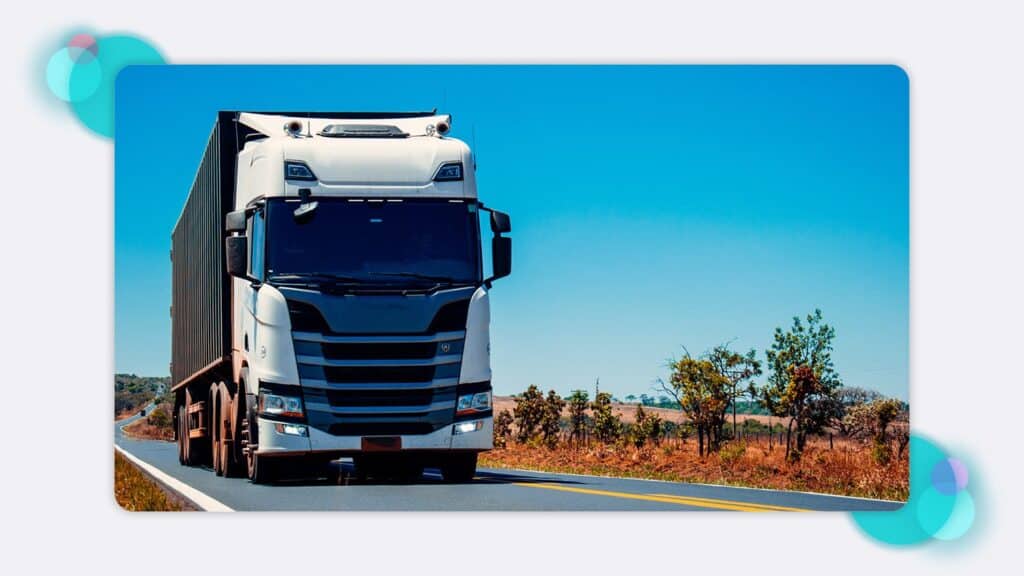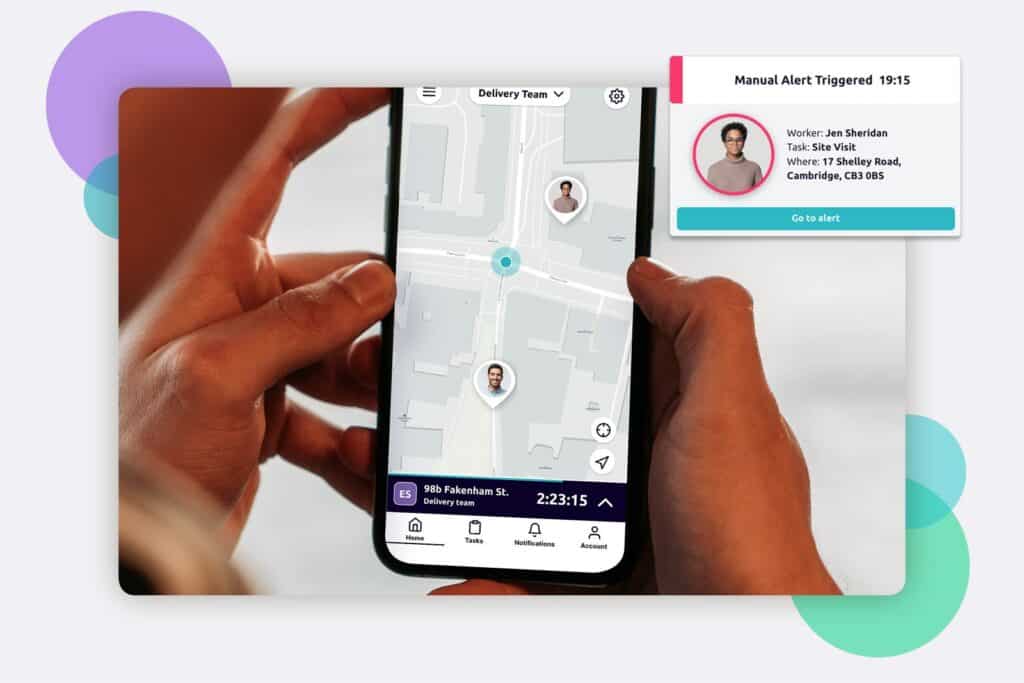
Lone working in transportation, logistics and haulage is so common that many workers may not even question it. For those that drive for a living –whether it involves buses, vans, cars, HGVs, trains or even bikes– it may be completely unremarkable to work alone for hours on end.
So what’s the risk? Whether someone works in public transport, logistics, deliveries or haulage, the largest risk appears to be traffic accidents.
In fact, the Health and Safety Executive (HSE) estimate that up to a third of all road traffic accidents involve someone who was at work at the time. For a sense of scale, in Great Britain there were 137,000 road incident casualties in 2021/2022*.
*This was actually lower than most years due to the lingering effects of covid.
“Driving for work is one of the most dangerous things workers will do”
— The UK’s Health and Safety executive

The definition of the “transport” industry can be difficult to pin down. For this article, we will largely be using statistics from the Health and Safety Executive (HSE)’s “transport and storage sector” –which includes:
We will be touching on nearly all aspects of this list but, in this article, we’re going to primarily be focusing on the movement of goods and passengers on roads.
A lone worker is someone who works out of sight or earshot of their colleagues for some or all of their day. Lone working, by its nature, can increase the risk of serious injury by lowering levels of oversight and increasing response times to potential emergencies.
For lone workers in the transport industry, threats will tend to come from other traffic (particularly if the worker is a vulnerable road user such as a bicycle courier) but there may also be hazards off the road. Workers who make deliveries may face aggression from members of the public, and delivery drivers may experience injuries while unloading goods.
As well as facing fairly novel risks around traffic, on-the-road workers can sometimes go hours without touching base with their team. Because of this, it is important for transport organisations to consider how they can keep connected with their staff –and what would happen if one of their staff members were injured while at work.

Risks for lone workers in transportation don’t end with operating on Britain’s massive network of roads and railways. Delivery drivers are at risk of theft or assault while taxi drivers or railway workers often work late or unusual shifts.
Risks can include:
Accidents while on the road, or involving vehicles.
According to the HSE’s 2022 report, ‘being struck by a moving vehicle’ was the most common cause of death for workers in this sector. Remember that the most vulnerable road users are pedestrians, motorcyclists and cyclists.
Slips, trips and falls.
Most active or hands-on roles face this risk, For the transport and storage sector, slips, trips and falls are the #1 cause of non-fatal injury.
Making deliveries or pickups.
There is always a risk when someone works alone with members of the public, especially if they are on their property. Risks can include aggressive customers and animals.
Handling of heavy goods.
This is particularly relevant to storage workers, but true of anyone who loads and offloads, including delivery drivers. Repetitive handling of heavy goods can lead to various musculoskeletal injuries –as discussed in our Aviation Industry article.
Threats aggression and violence from the public.
Anyone who works directly with the public can experience aggression, violence and harassment, but is a particular risk for public transport workers.
In fact, a 2021 staff survey of rail, buses and passenger ferries by the RMT suggested that 88% had suffered verbal abuse and 58% violence from passengers since the start of the pandemic.

The Health and Safety Executive (who states that ‘Driving for work’ is ‘one of the most dangerous things workers will do’) lays out very clear responsibilities for employers in this sector.
For example, ‘Driving and riding safely for work’ outlines the following four focus points:
When considering your responsibilities, it is important to remember that “Health and safety law applies to work activities on the road in the same way as it does on a fixed site”.
This means that employers in transportation (and related sectors) need to assess their employees’ potential risks, and take steps to mitigate them. This is the foundation of a good risk assessment.
With this in mind, transportation employers need to consider common risks such as:
Finally, it should be noted that the duty of care and safeguarding in transportation also extends to customers, be they passengers, passing public or people receiving deliveries.
RMT found that “66% of transport workers were working alone when they were subjected to violence and 56% reported that lone working had become more common since the pandemic began”
As we’ve mentioned, aggression, violence and abuse are a risk whenever an employee works with the public. For public transport workers, this risk has almost become a tragic inevitability. It is important that employers are realistic about the rates of harassment their staff face, and find solutions to mitigate it.
Training transportation lone workers in how to interact with the public and safeguard them against violence is one important route to protecting your staff. This may involve training in de-escalation, or training in how to get out of a dangerous situation.
Employers should develop a lone working policy that prepares their staff for all eventualities they might encounter as a lone worker in the transport sector.
As the industry grows and changes, be sure to keep this updated. If you add temporary delivery drivers or have a development site with heavy vehicles, your lone working policy needs to cover this.
As discussed, lone working can make the risks of your industry worse by slowing response times and making correct supervision more difficult.
For transportation employers, keeping track of staff can be particularly difficult. Telematic solutions can help track vehicles, but they can be expensive and limited. A vehicle-mounted telematic system will only help you keep track of the vehicle –keeping track of your team is a different matter.
What’s more, while phone calls are good for checking in on your team (which we really recommend, for your employee’s mental wellbeing), they are not a robust solution in the case of an emergency or accident.
If your team are attacked, in a traffic accident, or simply take a fall, and they are incapacitated, how will your team know there is an issue? That’s where Safepoint’s automated lone worker and team logistic solutions come in.
All sorts of businesses rely on Safepoint’s lone worker solutions and 24/7 Alarm Receiving Centre to keep their staff protected and organised. Some transport, delivery and logistic organisations that use Safepoint include:



As we’ve mentioned, lone workers can’t always call for help when they’re in trouble –and that’s especially true for transportation workers,
That’s why Safepoint has combined award-winning lone worker monitoring, with handy team logistic tools.
Whether your team are walking, cycling, or driving a car, bus, train, lorry, ferry, or anything else, they will have door to door, automatic protection.
Safepoint provides award-winning lone working solutions for workers in the transport and logistics sector along many other industries across the UK and abroad.
When drivers and other workers in the transport sector are equipped with Safepoint’s apps and wearable panic alarms, they can set up timed, GPS-tracked ‘tasks’ (such as ‘Castle Street delivery – 1 hour’).
If the worker runs into trouble, they can tap a button on their phone or wearable panic alarm and an alert will be sent out (along with their live location).
But what if a worker is incapacitated (for instance, if they have an accident)? With Safepoint, an alert will automatically be sent out if a user takes a fall (sometimes called a man-down feature) or if they are unresponsive.

Above: when an alert is triggered, it is handled by our GuardianPlus team and can be viewed in the web portal.
With Safepoint’s 24/7 GuardianPlus service, your team’s safety can be monitored day and night by an accredited team of expert responders.
These emergency response professionals, working out of a dedicated Alarm Receiving Centre (ARC), will handle any emergency –from first response, to escalation management, to liaising with the emergency services.
We at Safepoint know that full telematic solutions can be expensive, and fail to protect workers when they’re outside of the vehicle. That’s why we’ve brought lone working and team logistics together.
With Safepoint’s unique in-app team view, you can see where your team are, where they’re heading, how long they think their trip will take, and more. And because it’s app-based, the monitoring doesn’t stop when they leave the vehicle.
You can monitor your whole team from the Safepoint app or web portal. You can even see a historical log of all your team’s journey’s and statistics on their safety.
Check out the video below to see how Safepoint works. You can also try Safepoint for free, or you can book in a free demo!
Award-winning safety management tools and a fully accredited response team.